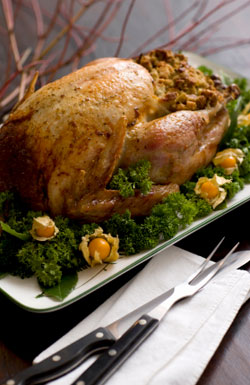How to Make Your Thanksgiving Turkey
There is nothing that says Thanksgiving like the smell of roast turkey wafting through your kitchen …  and the rest of the house. Of course, a roasted turkey can also be the centerpiece of any special family occasion or holiday.
and the rest of the house. Of course, a roasted turkey can also be the centerpiece of any special family occasion or holiday.
Despite its central role in family feasts, however, roasting a turkey can be a daunting task for many home cooks. Maybe they are afraid of the dreaded dry bird. Maybe they think a whole turkey is just too big to mess with. But roasting a turkey does not have to be a huge challenge. In fact, it is really quite simple.
The first step in ensuring that your Thanksgiving (or any day) bird is tender and succulent is to pick the right turkey. Here are some things you will want to keep in mind in choosing your turkey:
Fresh vs. Frozen
The biggest difference between a fresh and frozen bird is that a fresh turkey — which most grocery stores carry in abundance around Thanksgiving time — is ready to be prepped. Frozen birds, on the other hand, need to be thawed, which, depending on the size of the turkey, can take several days. That said, frozen turkeys tend to cost less — often times significantly less — than their fresh counterparts.
Size
As a general rule of thumb, plan on 1 to 1.5 pounds of uncooked turkey per guest at your Thanksgiving table. Error on the side of largeness if you want to enjoy left-overs the following day.
There are two types of turkeys: Hens, which are smaller, and toms, which are larger. Hen turkeys can run from less than 10 pounds to up to 17 or 18 pounds. Toms usually start around 18 pounds and can be as large as 25+ pounds. According to the University of Illinois’ Turkey Facts website, the average Thanksgiving turkey purchased in America is 15 pounds.
White vs. Dark Meat
A typical turkey is about 70 percent white meat and 30 percent dark meat. If your family exclusively prefers white meat, or if you are feeding a smaller crowd, you might want to consider choosing a turkey breast rather than a whole turkey. A turkey breast can be purchased boneless and skinless or bone-in and with the skin on. The latter is the preferred option if you want to be able to “stuff” your bird. The stuffing is fitted between the skin of the breast and the meat itself. Keep in mind, however, that with a breast, the stuffing will not be as infused with turkey flavor as it will when you cook a whole bird.
Once you have selected and defrosted (if necessary) your turkey, it is time to prep your bird. While some chefs swear by deep-frying their turkeys, the classic method of turkey preparation is roasting.
If you have never roasted a turkey before, or if your turkeys always turn out dry, here is a handy guide to preparing the perfect Thanksgiving bird.
- Preheat the oven to 350 degrees.
- Remove the turkey from its packaging, but save the wrapping for its information on suggested cooking times.
- Remove and discard the metal or plastic braces that are holding the legs in place.
- Remove the giblets and neck. If you plan to cook these with the bird or use them in your stuffing, set them aside. You can also freeze them (if your turkey was fresh) to use later for turkey stock. Or you can cook them (wrapped inside tin foil) and feed them to your pets.
- Wash the turkey thoroughly, inside and out, with cold running tap water. Water from the cavity of the bird should eventually run clear, i.e. no blood.
- Trim away any excess skin and fat from the neck and bottom of the turkey.
- Place the turkey, breast side up, in a non-shallow roasting pan.
- If you are planning to stuff the bird, you might want to first line the roasting pan with celery and onions or an herbal bundle (thyme, rosemary and sage all complement the natural flavor of turkey). Then stuff the bird with your homemade stuffing. (or check out our top rated stuffing recipes)
- If you are not planning to stuff the bird, fill the cavity with one or more of the following to enhance the flavor of the meat: celery and onions; an herb bouquet; chopped apples; or even a whole orange or lemon (punctured with fork tines to release more flavor).
- Pour a stick of melted butter or margarine over the turkey. Some cut calories by spraying the turkey with a flavored non-stick spray, such as Pam®. While the spray does help the skin to crisp up, it does not produce as much flavorful gravy as butter and margarine do.
- Season the turkey by rubbing herbs or seasoning in to the skin of the bird. Chose from any combination of freshly ground sea salt, freshly ground black pepper, dried onions or onion powder, minced garlic, sage, savory, lemon pepper, lemon juice or basil. Let your taste buds — and your imagination — guide you.
- Pour 2 cups of water into the bottom of the roasting pan and insert a meat thermometer deep into the thigh area.
- Place the pan into the preheated oven. Open the oven door first, as the pan will be extremely heavy, particularly if your bird is stuffed. Set a timer for the length of time recommended on the packaging, which will be between three and six hours, depending on the size of the turkey (and your individual oven). Be sure to check on the bird every hour and baste it each time. When done, the outside skin will be brown and lightly crispy, the meat thermometer will register at least 180 degrees, and both legs and wings will move easily. A well-cooked bird will have tender, moist meat; an overcooked one will have dry (and potentially flavorless) meat.
- Remove the turkey from oven and let it sit on your counter for about 20-30 minutes before carving. Cover with a roasting pan lid, especially if you have animals at home.
And there you have it: 14 relatively simple steps to the perfect Thanksgiving turkey.
If you should get stuck along the way (which you won’t as roasting a turkey is really quite simple), you can call the USDA’s Meat and Poultry Hotline. The toll-free number is 1-800-535-4555.
Bon Appetite.
Looking for Turkey and other holiday recipes? Check out our holiday recipe site – Holiday Eats for all your Thanksgiving and holiday recipes.



